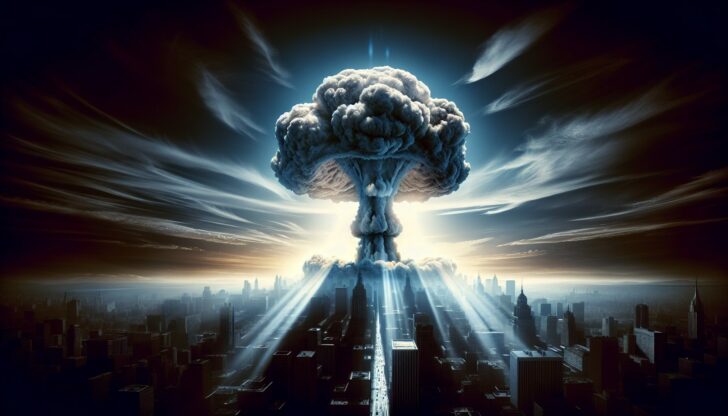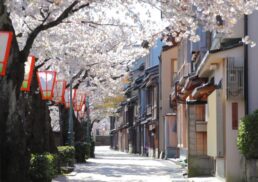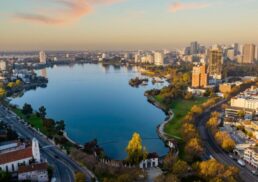The blast radius of Hiroshima’s atomic bomb, ‘Little Boy,’ obliterated almost everything within 1.6 kilometers of the explosion site. Buildings were destroyed, fires ignited instantly, and a lethal overpressure extended even further. This article explores the “blast radius of Hiroshima” and how the bomb’s devastating effects unfolded, examining the immediate destruction and long-term impact on the city and its inhabitants.
Table of Contents
Key Takeaways
The atomic bombing of Hiroshima on August 6, 1945, caused catastrophic physical devastation and irrevocably transformed the city’s landscape and the lives of its inhabitants.
The detonation of ‘Little Boy’ led to immediate and widespread structural damage, severe casualties, and secondary fires, creating a comprehensive landscape of destruction and despair.
Radiation effects from the atomic bomb caused severe, long-term health issues for survivors, including increased cancer risk, and the bombing spurred a prolonged historical debate on its necessity and morality.
The Hiroshima Bombing: An Overview

The history of Hiroshima extends far beyond the catastrophic day of August 6, 1945. Here are some key milestones in Hiroshima’s history:
Established as a prefecture in 1871 following the Meiji Restoration
Hiroshima City was founded in 1889 and rapidly developed into an economic and political center in western Japan
The construction of the Ujina port and the introduction of streetcars in 1912 significantly enhanced its transportation network, further cementing its status
By the time World War II erupted, Hiroshima had evolved into an industrial and educational hub, boasting a thriving spinning industry and various educational institutions. The city’s strategic importance grew as it became the core city of the Chugoku and Shikoku regions, hosting the Headquarters of the Second General Army by the end of the Pacific War. This made Hiroshima a significant military target during the conflict.
Hiroshima’s atomic bombing, a pivotal moment in World War II, symbolized the enormous destructive potential of nuclear weapons. The bombings of Hiroshima and Nagasaki, including the second atomic bomb, aimed to expedite Japan’s surrender to prevent a drawn-out, violent invasion. However, the atomic explosion that destroyed Hiroshima’s identity had far-reaching consequences that extended beyond the immediate military objectives.
Detonation of Little Boy
In the early morning hours of August 6, 1945, a B-29 bomber named Enola Gay took off from the island of Tinian, carrying with it the fate of Hiroshima. Piloted by Colonel Paul Tibbets, the Enola Gay flew at low altitude before climbing to 31,000 feet as it approached its target. The mission underwent careful planning, selecting Hiroshima due to its military importance and relatively preserved infrastructure.
At precisely 8:15 a.m. Hiroshima time, the Enola Gay released ‘Little Boy,’ a 9,700-pound uranium gun-type bomb, over the city. Forty-three seconds later, Little Boy detonated 1,900 feet above Hiroshima, directly over a parade field where soldiers were performing calisthenics. The resulting atomic explosion was equivalent to 15,000 tons of TNT, unleashing unprecedented destructive force, similar to what the fat man atomic bomb would later demonstrate.
The detonation of Little Boy had the following effects on Hiroshima:
The atomic fireball reached a maximum diameter of 900 feet within less than a second
The blast totally destroyed everything within a one-mile radius
Buildings were obliterated
Fires sprang up instantaneously as the heat from the explosion ignited materials across the city
The atomic bomb’s impact on Hiroshima was immediate, catastrophic, and irreversible.
The unleashing of ‘Little Boy’ and the ensuing atomic explosion resulted in:
substantial physical devastation
a total upheaval of the lives of Hiroshima’s inhabitants
the transformation of the city into a landscape of desolation and ruin
The power of nuclear weapons had been demonstrated with devastating clarity, forever changing the nature of global warfare and international relations.
Immediate Blast Effects
The atomic explosion’s immediate aftermath was simultaneously terrifying and startling. The blast wave from the explosion traveled at a staggering 984 miles per hour, shattering windows up to ten miles away and demolishing buildings within a one-mile radius. The blast pressure waves were felt as far as 37 miles from the epicenter, underscoring the immense power of the atomic bomb.
The effects of the Hiroshima bomb were devastating:
The fireball from the bomb expanded to 900 feet in less than a second, engulfing everything in its path.
Over two-thirds of Hiroshima’s buildings were demolished by the blast.
Reinforced concrete buildings near the explosion’s center remained standing but suffered extensive interior damage and fires.
The blast wave’s ability to cause massive structural collapse and subsequent fires highlighted the destructive synergy of heat and pressure.
In addition to the physical destruction, the atomic explosion caused immediate and severe casualties. The pure blast effect alone resulted in a negligible number of casualties compared to other effects, but the combination of heat, pressure, and flying debris led to widespread injuries and death. Fires that started instantaneously were later extinguished by the pressure blast, creating a complex interaction between heat and pressure in causing fires.
The immediate aftermath of the atomic blast was a scene of chaos and devastation, with the city of Hiroshima left in ruins.
Extent of the Blast Radius
The blast radius of the Hiroshima bomb was astonishingly extensive. The explosion radius of ‘Little Boy’ was approximately 1.3 kilometers, with almost everything within 1.6 kilometers of the point directly under the explosion being completely destroyed. The severity of the damage decreased with distance, but the lethal blast overpressure was experienced by people within a 3.5-kilometer diameter.
The perimeter of severe blast damage approximately followed the 5 pounds per square inch (34 kPa) contour at 1.8 kilometers. This roughly circular area of destruction underscored the immense power of the atomic explosion, which left a wide, flat central area of Hiroshima in ruins. The blast wave traveled outward, affecting a vast area and leaving a lasting impact on the city’s landscape and its inhabitants.
Firestorm and Secondary Fires
The catastrophic firestorm, a consequence of the atomic explosion, further compounded Hiroshima’s dire circumstances. The intense heat of the atomic explosion caused the primary fires to start instantly. This rapid ignition resulted from the extreme temperatures. These fires quickly spread, fueled by the abundance of combustible materials in the city.
Secondary fires emerged as collapsing buildings, damaged electrical systems, and overturned stoves ignited further blazes. The combination of primary and secondary fires created a perfect environment for a devastating fire storm, which requires at least 8 pounds of combustibles per square foot and a burning area of at least 0.5 square miles to develop. In contrast to ordinary mass incendiary raids, the firestorm in Hiroshima ultimately destroyed approximately 4.4 square miles of the city.
Unlike Hiroshima, Nagasaki did not experience a firestorm due to its uneven terrain. The high winds blowing inwards during the firestorm, combined with the resulting terrific conflagration, burned everything in their path, creating a badly burned area that extended far beyond the initial blast zone.
The fires caused by the atomic explosion not only compounded the suffering and destruction, but also completely destroyed Hiroshima’s identity, leaving it a charred and devastated landscape as a devastating fire storm resulted, with a badly burned area extended. Many buildings suffered extensive damage, further highlighting the severity of the event.
Radiation Effects
The atomic bomb’s radiation effects were as pernicious as they were lethal. Flash burns were caused by the almost instantaneous radiation of heat at the moment of the explosion, leading to severe skin injuries among those exposed. Radiation injuries manifested in various ways, with key symptoms including:
hair loss (epilation)
bleeding into the skin (petechiae)
vomiting
diarrhea
fever
Epilation, particularly on the scalp, was a highly noticeable symptom among radiation-affected patients. Hemorrhagic manifestations, such as bleeding from gums and needle punctures, were common, indicating the severe internal damage caused by radiation exposure. Patients also exhibited inflammation and ulceration in the mouth and throat, often accompanied by low white blood cell counts (leucopenia).
Eye damage, such as retinal hemorrhages, was observed in many patients, further highlighting the extensive impact of radiation. Deaths due to radiation peaked 3 to 4 weeks after exposure and ceased after 7 to 8 weeks, underscoring the delayed yet deadly nature of radiation injuries. The effective radiations occurred not only caused immediate health crises but also had long-term implications for the survivors.
The radiation effects of the Hiroshima bomb extended beyond physical injuries. Survivors faced long-term health issues and an increased risk of cancer and other illnesses. The gamma radiations emitted during the nuclear explosion had lasting effects on the population, making radiation one of the most devastating aspects of the atomic bombings.
Aftermath and Reconstruction
Hiroshima’s bombing aftermath was characterized by a desperate fight for survival and a massive rebuilding effort. By the end of 1945, the death toll in Hiroshima was estimated to be over 100,000, with many more suffering from lingering radiation effects. The atomic bombing completely destroyed Hiroshima’s public infrastructure, including transportation, communication, water, and sewage systems.
Despite the extensive damage, efforts to restore normalcy and normal city life began almost immediately. Here are some key milestones in the restoration process:
Two days after the bombing, the Japanese National Railways Sanyo Line reopened between Hiroshima and Yokogawa.
Streetcar operations partially resumed three days after the bombing.
Water pumps were operational within four days, although it took nine months to fully restore the water supply.
Hiroshima’s reconstruction included ambitious plans for:
wide roads
parks
green areas
land readjustments
In 1949, the Hiroshima Peace Memorial City Construction Law was enacted to provide special assistance for the city’s reconstruction. The Peace Memorial Park and the Hiroshima Peace Memorial Museum, completed in 1955, stand as enduring symbols of the city’s resilience and commitment to peace.
The reconstruction of Hiroshima was not just about rebuilding a city; it was about healing a community and fostering a global dialogue on peace.
Controversies and Historical Debate
The atomic bombings of Hiroshima and Nagasaki have been the topic of prolonged controversy and historical discussion. Supporters argue that the bombings were necessary to prevent an invasion of Japan, potentially saving more lives. They believe the atomic bombs were essential for a speedy end to World War II and for preventing further loss of American lives.
Opponents, however, contend that the atomic bombings were unnecessary and may have constituted war crimes or genocide. They argue that Japan was already on the brink of surrender and that the bombings were not the decisive factor in ending the war. Public opinion on the bombings has evolved over time, with initial strong support in the United States shifting as the human impact of the bombings became more widely understood.
The debate remains a poignant reminder of the complexities and moral dilemmas associated with the use of nuclear weapons.
Summary
Reflecting on the Hiroshima bombing, it is clear that this single event had far-reaching consequences that extended well beyond the immediate destruction. The atomic bomb not only obliterated a city but also profoundly impacted the lives of countless individuals and altered the course of history. The immediate blast effects, the devastating firestorm, the insidious radiation injuries, and the subsequent reconstruction efforts all paint a vivid picture of the immense power and human cost of nuclear weapons.
As we continue to grapple with the legacy of Hiroshima, it is crucial to remember the lessons learned from this tragedy. The story of Hiroshima serves as a powerful reminder of the need for peace and the importance of preventing such devastation from occurring again. The resilience of the Hiroshima community and their commitment to peace inspire us to strive for a world free from the threat of nuclear weapons.
Frequently Asked Questions
What was the primary reason for choosing Hiroshima as the target for the atomic bomb?
The primary reason for choosing Hiroshima as the target for the atomic bomb was its military significance, relatively undamaged infrastructure, and its role as the headquarters of the Second General Army during World War II. These factors made it a strategic choice for the attack.
How did the immediate blast effects of the atomic bomb impact Hiroshima?
The immediate blast effects of the atomic bomb in Hiroshima included a powerful blast wave that destroyed buildings, shattered windows up to ten miles away, and caused extensive fires, leading to the destruction of over two-thirds of the city’s buildings.
What were the long-term health consequences of radiation exposure from the Hiroshima bomb?
The long-term health consequences of radiation exposure from the Hiroshima bomb included radiation injuries like hair loss, internal bleeding, vomiting, increased cancer risk, eye damage, and severe health issues for survivors.
How did Hiroshima rebuild after the atomic bombing?
Hiroshima began reconstruction efforts almost immediately after the atomic bombing, restoring basic services, enacting the Hiroshima Peace Memorial City Construction Law, and developing ambitious plans for wide roads, parks, and green areas, with the establishment of Peace Memorial Park and Museum as symbols of peace and resilience.
What are the main arguments in the controversy surrounding the atomic bombings of Hiroshima and Nagasaki?
The main arguments in the controversy surrounding the atomic bombings of Hiroshima and Nagasaki center around whether the bombings were necessary to prevent an invasion of Japan and save lives, or if they were unnecessary and may have constituted war crimes. There are also differing views on whether the bombings were the decisive factor in Japan’s surrender.









